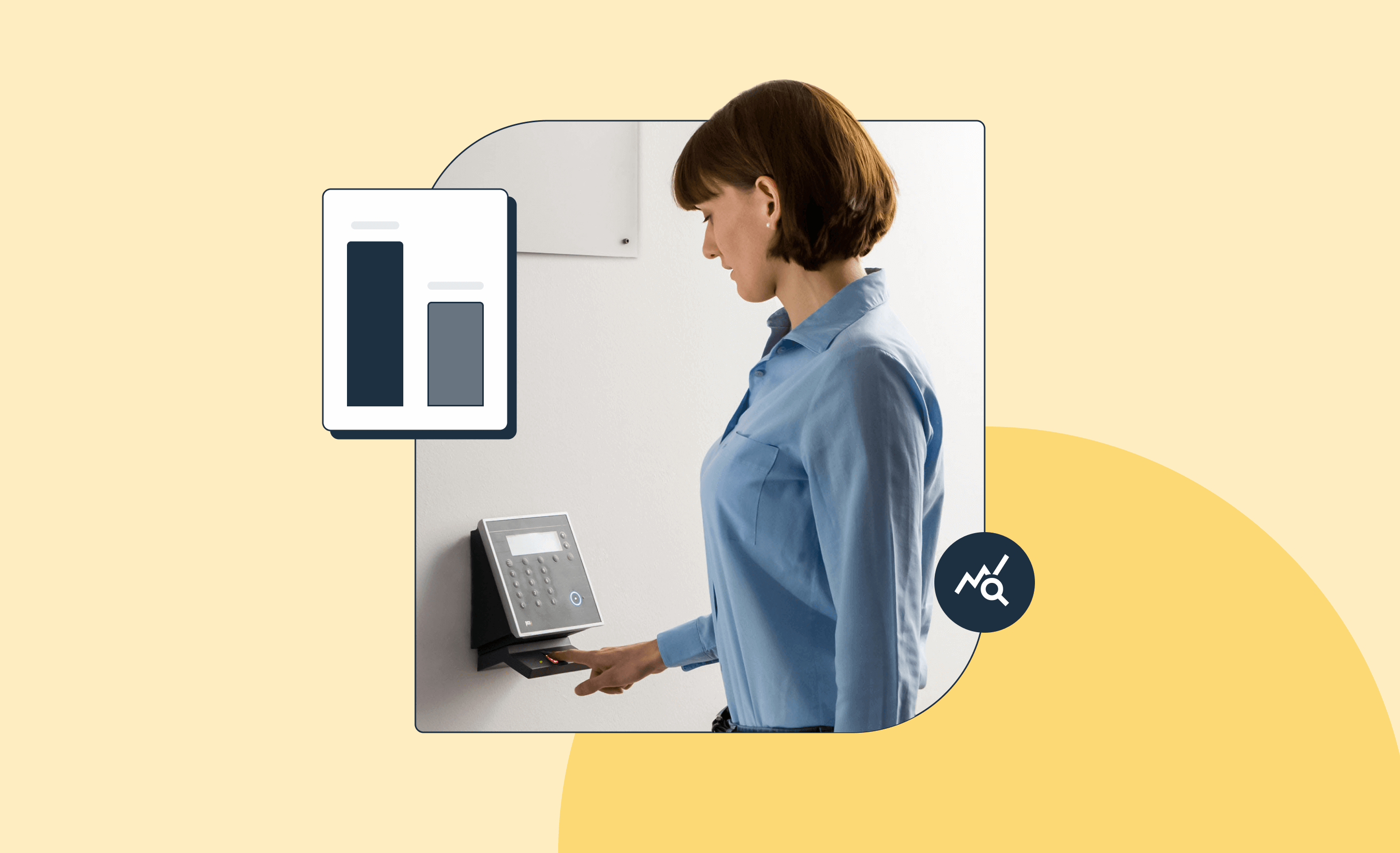Welcome to our curated and vetted list of 29+ biometrics statistics for 2025.
Top Biometrics Statistics
- By 2025, the global biometric system market is expected to hit nearly $68.6B.
- As of 2022, biometrics are enabled on 81% of smartphones.
- In 2023, 46% of passengers used biometrics at airports, a jump from 34% in 2022.
- More than 176M Americans use facial recognition technology.
Market Overview
01. By 2025, the global biometric system market is expected to hit $68.60B.
| Global Biometric System Market Revenue: 2020–2027 | In Billion USD |
|---|---|
| 2020 | 36.60 |
| 2022 | 42.90 |
| 2025* | 68.60 |
| 2027* | 82.90 |
02. The worldwide digital identity solution market is set to grow from $28B in 2022 to about $71B in 2027.
| Global Value of the Digital Identity Solution Market: 2020–2027 | In Billion USD |
|---|---|
| 2020 | 23.30 |
| 2022 | 27.90 |
| 2026* | 49.50 |
| 2027* | 70.70 |
03. The global biometric authentication and identification market is set to hit nearly $100B by 2027, growing at a 14.6% annual rate from 2019.
| Worldwide Market Size for Biometric Authentication and Identification: 2019 vs 2027 | In Billion USD |
|---|---|
| 2019 | 33.26 |
| 2027* | 99.63 |
04. The European market for human augmentation, including AR, VR, biometrics, and more, is expected to soar from $57.83B in 2022 to $219.63B in 2029.
05. The AFIS (automated fingerprint identification systems) market, valued at $5.32B in 2022, is expected to grow to $15.42B by 2028.
| Worldwide AFIS Market Value: 2022 vs. 2028 | In Billion USD |
|---|---|
| 2022 | 5.32 |
| 2028* | 15.42 |
06. Valued at about $5B in 2022, the facial recognition market revenue is expected to expand to $19.3B by 2032.
| Global Facial Recognition Market Revenue: 2019–2032 | In Billion USD |
|---|---|
| 2019 | 4.35 |
| 2020 | 3.60 |
| 2021 | 5.01 |
| 2022 | 5.50 |
| 2032* | 19.30 |
07. The contactless biometric technologies market, valued at an estimated $12.07B in 2024, is expected to grow to $37.1B by 2030.
| Global Contactless Biometric Technologies Market Value: 2020–2030 | In Billion USD |
|---|---|
| 2020 | 5.79 |
| 2021 | 6.95 |
| 2022* | 8.35 |
| 2023* | 10.03 |
| 2024* | 12.07 |
| 2025* | 14.53 |
| 2026* | 17.50 |
| 2027* | 21.09 |
| 2028* | 25.44 |
| 2029* | 30.71 |
| 2030* | 37.10 |
08. The market for iris recognition is projected to exceed $8B by 2027.
| Global Iris Recognition Market Value: 2019–2027 | In Billion USD |
|---|---|
| 2019 | 0.68 |
| 2021 | 2.90 |
| 2026* | 1.85 |
| 2027* | 8.40 |
09. Growing at a 23.7% CAGR, the global voice recognition market is expected to expand from $9.56B in 2021 to $49.79B by 2029.
| Worldwide Market Size of Voice Recognition: 2021–2029 | In Billion USD |
|---|---|
| 2021 | 9.56 |
| 2022 | 11.21 |
| 2029* | 49.79 |
10. The signature verification market, valued at $957.24M in 2019, is expected to expand to $4.8B by 2026.
| Global Signature Verification Market Value: 2019–2026 | In Million USD |
|---|---|
| 2019 | 957.24 |
| 2026* | 4,795.57 |
Sources: Fortune Business Insights, GlobeNewswire, Market Research Future, MarketsandMarkets, Mordor Intelligence, Precedence Research, Research and Markets, Statista #1, Statista #2, Stellar Market Research
Usage and Public Perception of Biometrics
11. In 2023, 46% of passengers used biometrics at airports, a jump from 34% in 2022.
12. A significant 75% of travelers prefer biometrics to conventional passports and boarding passes.
13. Roughly 46% of travelers who’ve used biometric identification report an 85% satisfaction rate.
14. About 40% of travelers would be more open to biometric solutions if they knew their personal information was secure, a jump from 33% in 2022.
15. As of 2022, biometrics are enabled on 81% of smartphones.

16. More than 176M Americans use facial recognition technology, 131M of whom use it daily.
17. The most prevalent use of facial recognition is for unlocking phones, laptops, and personal computers (68%).
| Primary Applications of Facial Recognition Technology | In % |
|---|---|
| Unlocking a phone, laptop, or another personal computer | 68 |
| Logging in to an app on a phone, such as a healthcare portal or ticketing app | 51 |
| Accessing a bank account or another financial institution | 42 |
18. Americans are most receptive to facial recognition for enhanced safety at airports (55%), banks (54%), and medical offices (53%).
| Where Are You Most Open to the Use of Facial Recognition Technology for Improved Safety? | In % |
|---|---|
| Airports | 55 |
| Banks | 54 |
| Medical offices | 53 |
| Offices | 39 |
| Hotels | 30 |
| Sports stadiums | 29 |
| Public transportation | 28 |
| Retail and grocery stores | 26 |
| Restaurants | 23 |
19. Facial recognition for saving preferences on shared equipment (e.g., at gyms) is used by 12% of people aged 18–34, versus 6% of those aged 35–54 and 1% over 55.
20. In the 18–34 age group, 15% use facial recognition for accessing work and clocking in/out, compared to 9% (35–54 age group) and 3% (55+).
21. Most Americans (81%) approve of facial recognition for passport controls.
| Acceptance of Facial Recognition in the US by Case (2022) | In % |
|---|---|
| Passport control | 81 |
| Building access | 72 |
| Police surveillance | 55 |
| Retail purchase | 49 |
| Emotion analysis | 42 |
| Personalized advertising | 40 |
22. In 2022, the primary concerns with biometric technologies were linked databases causing mass surveillance (73%) and misidentification (59%).
| Global Concerns regarding Biometrics (2022) | In % |
|---|---|
| Linked databases leading to mass surveillance | 73 |
| Misidentification | 59 |
| Demographic differentials/ bias | 56 |
| Watchlists | 35 |
| Use in social media | 35 |
| Commercial uses | 20 |
| Police use of body-worn cameras | 10 |
| Ancestry/DNA testing | 11 |
| Hygiene/ health concerns | 8 |
| Other | 3 |
| Nothing – the public isn’t concerned | 4 |
Sources: Biometrics Institute, Duo Security, FaceMe, GetApp, Passenger Terminal Today
Emerging Trends and Forecasts in Biometric Technologies
23. Over half (54%) of industry experts cite privacy and data protection concerns as the primary restraint on the biometrics market.
| What Are the Main Limitations of the Biometrics Market? | In % |
|---|---|
| Privacy/data protection concerns | 54 |
| Lack of public trust | 47 |
| Legislation and governance | 43 |
| Misinformation about biometrics | 37 |
| Data sharing concerns | 33 |
24. A majority (57%) of industry experts doubt that policy and regulation will keep up with biometric tech advancements to ensure privacy and data protection.
25. Nearly 54% of industry professionals believe that by 2030, people will routinely consider future data custodians when sharing biometric data with organizations.
26. Industry professionals anticipate AI (26%) to lead in the most significant biometric developments over the next five years.
| Which Areas Will See the Greatest Biometrics Advancement in the Next 5 Years? | In % |
|---|---|
| Artificial intelligence | 26 |
| Digital identity | 22 |
| Digital wallets | 9 |
| National identity | 7 |
| Border control/security | 6 |
27. A significant 87% of industry professionals believe that public perception of emerging AI technologies will impact their outlook on future biometric applications.
28. Industry professionals (87%) agree that extensive citizen education on data protection and privacy, including specific implementations, is key to advancing biometric acceptance.
29. Most experts foresee facial recognition (45%) to have the highest growth in usage, followed by multimodal (16%).
| What Biometric Technology Is Anticipated to Experience the Most Significant Increase in Usage? | In % |
|---|---|
| Face | 45 |
| Multimodal | 16 |
| Voice | 9 |
| Iris | 7 |
| Behavioural | 6 |
Sources: Biometrics Institute
Stacking It All Up
That concludes our deep dive into biometrics statistics.
If you think this information would benefit your audience, you’re welcome to share it. Just remember to link back to this page as a nod to our efforts.

As a Digital PR specialist and a member of the Society of Professional Journalists (SPJ), I have 5+ years of writing experience.
Over the course of my career, my work has garnered significant attention, with features in numerous prominent publications such as The New York Times, Forbes, Inc., Business Insider, Fast Company, Entrepreneur, BBC, TechRepublic, Glassdoor, and G2.









